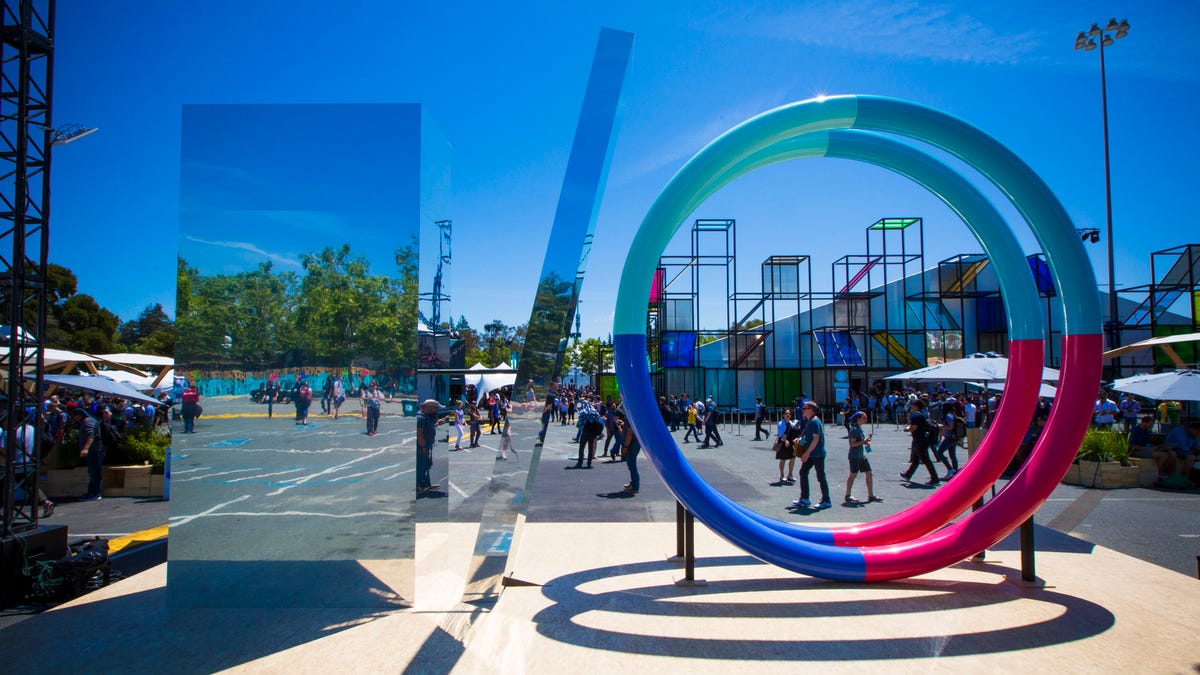From nerd heaven to Coachella Lite: Man, Google I/O has changed
Commentary: To appreciate the significance of Google's annual conference for developers and press, you have to go way back to the very first one in 2008.

The very first Google I/O conference didn't have the puffy white tents or long lines of this year's show, held at an outdoor concert venue in Mountain View, California -- and it certainly didn't have attendees fretting about seagull droppings splatting down from overhead. We would know. We were there.
Marissa Mayer, then a Google VP, addresses the crowd at Google I/O 2008, its first developer conference.
What the Google I/O of 2008 had was a lot of geeky developers who were interested in this shaky little brand-new phone thing called Android, plus a few journalists like us who wanted to know what Google would say. Google had held two previous single-day developer events, but this was its first full-blown conference.
And it was nerd heaven.
We filed into the smallest building of San Francisco's Moscone Center in a civilized way (nobody ran or pushed or made you feel like corralled cattle). Up on stage, Marissa Mayer, now Yahoo's CEO, then Google's vice president of search products and user experience, spoke about the wonders of split A/B testing.
But the highlight of the show, hands-down, was the very first prototype Android phone, that included -- get this -- technology called a touchscreen! Even that first prototype had a prominent Google search bar, which telegraphed the basic purpose of Android: drive the people who own the phones into using Google's services.
Back then, though, BlackBerry was still a commanding power, and phone owners were comfortable using a stylus, scroll wheels and hardware keyboards to navigate their phones. Apple's iPhone -- introduced just a year earlier, and still lacking an app store -- helped popularize the touchscreen, and Google's Android team was quick to join the trend.
This newbie Android prototype didn't even support multitouch actions like pinch to zoom. What it did have was 3G networking and a mere 128MB of memory -- though Google needed twice that to run Adobe Systems' Flash (a software feature Google tried to use early on to differentiate Android from the more established iPhone OS, later called iOS). 128MB is unbelievably small by today's memory standards. The recently released Samsung Galaxy S7 has about 30 times that amount.
Android's first app champions
Sessions were appropriately in-the-weeds geeky, and tough to translate for the regular consumer. But there was so much to learn and explore (not to mention 3,500 pounds of snacks such as gummy bears and M&Ms). CNET sat down on colorful bean bags in the quiet open space during and between other sessions to chat with the earliest Android programmers.
These were mostly individuals or small teams of people, not big-name brands, just enthusiastic programmers who had entered Google's contest to kickstart the Android app ecosystem at a time when the mobile world was just discovering how powerful and popular third-party apps could be.
The apps were simple by today's standards, with just two or three panes for finding a local music station, for instance. Developers wanted to make money, sure, but seemed more interested in exploring the possibilities of programming not just for a touchscreen, but also for a promising new ecosystem that could leverage Google's dominating ads and search.
Oh, how I/O has changed
Since those humble days, Google I/O has matured into a cooler, slicker version of itself. In 2012, its rockstar cofounder Sergey Brin narrated as skydivers wearing Google Glass converged on the keynote, and in 2016, evening entertainment pulls in chart-topping, clubber mainstays like Kygo and Charli XCX.
Jemaine Clement, left, and Bret McKenzie, otherwise known as Flight of the Conchords, entertained developers and press at the very first Google I/O.
You know who entertained us at the very first Google I/O? Flight of the Conchords! And they were nerdily awesome.
Google I/O hasn't just grown. It's blown up, and that's clear at this show, with its laid-back music-festival vibe. 2,500 people attended the first two-day I/O; today, the three-day event is home to 7,000 developer attendees and Google live-streams it to millions on the Internet.
Although it's grown more polished year after year, a change befitting Google's place at the top of the Internet services food chain, the attitude on the ground is a little different than in past years when we crammed into Moscone, zinging off each other's energy with plenty of consumer devices to play with and brand-new Android features to demo.
In a way, this is a more developer-centric show that refocuses on technical sessions and coder's clinics. This is where software engineers tackle the important work that will create the apps that will hook into the exciting products Google announced, but isn't ready to show: VR headsets, Google's potentially industry-gobbling Home connected speaker, and more capable Android watches with standalone programs that don't need your phone.
Google I/O may have changed from a campfire to a circus, but its goal -- to get people to make things for Google's ever-expanding platform -- has not.



